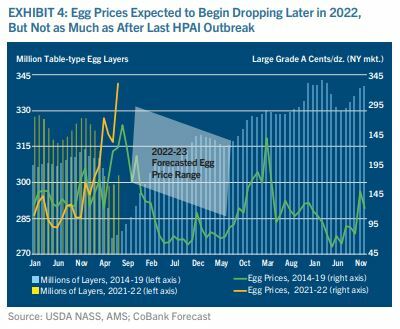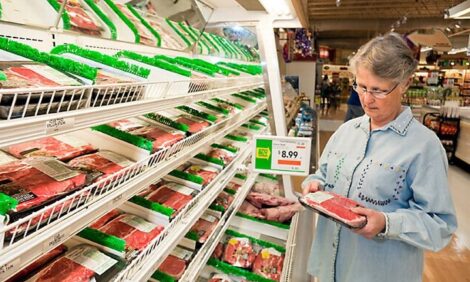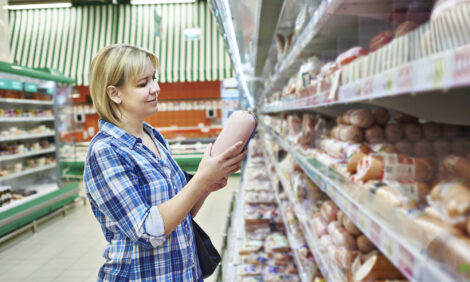



Avian influenza remains persistent threat to US poultry supplies, export markets
Poultry producers, exporters and consumers increasingly vulnerable to future HPAI market shocksThe widespread outbreak of Highly Pathogenic Avian
Influenza (HPAI) that roiled U.S. poultry production earlier this year and led
to skyrocketing prices for eggs and turkey has subsided. Cases of HPAI
diminished significantly as temperatures warmed and the migratory season for
wild birds ended. However, the risk of another outbreak this fall remains
elevated and the stakes for poultry producers couldn’t be higher, according to
a new report from CoBank’s Knowledge
Exchange.
Poultry product values had increased substantially prior to this year’s HPAI outbreak due to tight supplies and strong consumer demand for animal protein products. The added burden of HPAI-related supply shocks further exacerbated tight market conditions, sending values skyrocketing. Table egg prices tripled in several markets and turkey breast meat rose to historic peaks.
Similarly, the value of U.S. poultry exports through June was up 19% year-over-year. In 2021, total U.S. poultry exports reached $5.9 billion, and the current pace of exports indicate a potential all-time record high in 2022. The increased dependence on export markets for certain poultry items like chicken paws and leg quarters brings added vulnerability for exporters subject to potential trade restrictions that could result from future HPAI outbreaks.
“Fortunately for U.S. poultry exporters, the current world views on HPAI trade restrictions have relaxed since the last major outbreak in 2014 and 2015,” said Brian Earnest, lead animal protein economist with CoBank. “Rather than a blanket ban, trade partners set new restrictions at county, state or regional levels because outbreaks had become commonplace globally, and not coincidentally, because politicians across the globe were concerned about rapidly escalating food prices after Russia’s invasion of Ukraine.”
While current trade restrictions are limited, that could change. At the outset of the HPAI outbreak in 2014, China immediately closed its borders to U.S. poultry, and export-dependent leg quarter prices fell by 50% between mid-2014 and mid-2015. Chicken paw prices fell by even more. China’s markets would not reopen to U.S. poultry until 2019, which occurred as a part of the U.S.-China Phase One trade deal.
The 2014-15 HPAI outbreak devastated U.S. producers, with direct costs associated with euthanizing and depopulating 43.2 million laying hens and 7.3 million turkeys estimated at $1.6 billion. Including the associated recovery costs, the total jumped to more than $3.3 billion.
Since that outbreak, U.S. poultry production grew an average of 2% per year from 2016 to 2020. Reliance on exports has continued to climb, and access to foreign markets remains vital for the U.S. poultry industry. With the stakes that much higher, it is even more crucial to producers, consumers and other entities throughout the value chain that the production stream is secure from the threat of animal disease.
What’s Ahead for Egg, Turkey and Broiler Markets
The HPAI shock to domestic markets has been more severe than in the 2014-15 outbreak, which is considered the largest outbreak in history. The sectors hit the hardest this year are egg and turkey producers, much like in the 2014-15 outbreak. And while the industries have implemented best practices over the past seven years, production methods have not changed significantly.

In 2015, the U.S. egg industry saw an immediate rise in productivity rates after the mass depopulation, followed by flattening for several years. With feed, labor and other production costs much higher today, Earnest expects producers will be slower to rebuild their flocks this time around. “A smaller national layer flock means a smaller egg supply in coming months, higher egg prices, and fewer eggs consumed,” he said.
Coinciding with HPAI outbreaks in U.S. turkey flocks this year, wholesale spot market values for fresh tom breast meat has eclipsed $6.50 per pound in recent weeks, a level previously deemed unattainable. At the same time, breast meat in cold storage dwindled to a low of just 43 million pounds in April, before safety stocks began building again slightly during May.
The HPAI impact on broiler meat production in both 2015 and 2022 appears minimal. But the impact on exports and prices is decidedly different this time around. U.S. broiler meat exports declined by nearly one billion pounds in 2015 and dark meat prices plunged. However, export markets appear more favorable for U.S. broiler meat in 2022. The current 12-month total is within 1% of volume reported a year earlier and the total for 2022 is on pace to best 2015 volume by more than one billion pounds.









